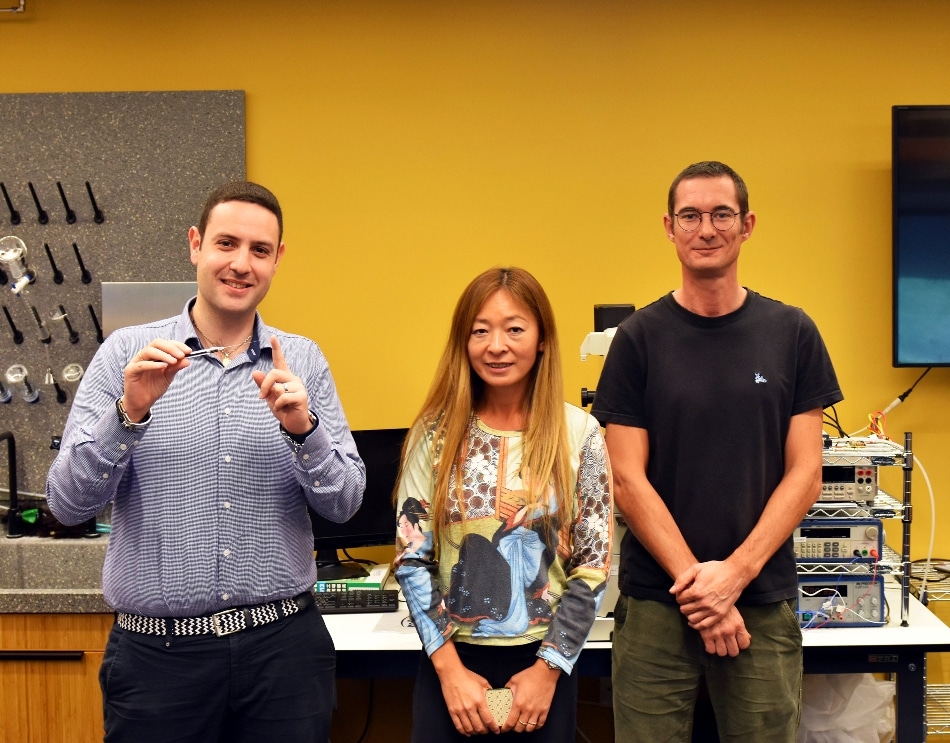Apr 25 2017
 (From left to right) Dr. Francesco Del Giudice holding a microfluidic device, Prof. Amy Shen and Dr. Simon Haward from the Micro/Bio/Nanofluidics Unit. Creidt: OIST
(From left to right) Dr. Francesco Del Giudice holding a microfluidic device, Prof. Amy Shen and Dr. Simon Haward from the Micro/Bio/Nanofluidics Unit. Creidt: OIST
Developing “lab on a chip” devices proves to be a significant step forward in future healthcare. Distinct from electronic chips used in computers, these “chips” are small devices into which biological fluids such as urine or blood are introduced to fill explicitly designed microscopic channels comprising biosensors with the ability to detect specific markers of diseases within the fluids and to ensure fast diagnosis.
Although the device measures just a few centimeters, a broad range of analyses can be carried on the device. Yet, one main problem is the size of the fluid sample introduced into the chip, which is just one-billionth of a liter. The lack of existing techniques renders researchers unable to have an in-depth knowledge on the behavior of fluids, specifically complex fluids of biological origins, at very small scales.
Prof. Amy Shen and her colleagues from the Micro/Bio/Nanofluidics Unit at OIST have been working towards enabling the usage of microfluidics as a means to unearth the principles and laws governing the complex fluids’ behavior at the microscopic scale. In the second phase, they apply their findings to enable direct applications in biotechnology and healthcare. The new discoveries by the research team have been published in the Journal of Rheology published by the American Institute of Physics.
Characterizing the behavior of polymer solutions at the microscopic scale
Polymers are made by repeated linking of multiple units of large molecules and are present everywhere from fabrics to rubber and polystyrene. Liquid polymer solutions are present in various commercial items such as household cleaning agents and paint. However, polymer solutions can dramatically enhance the diagnostic tools only at the microscopic scale.
“When you add a polymer to a suspension of particles in water, you trigger a new phenomenon in the microfluidic channel”, explained Dr Del Giudice. “These polymers start acting as springs to kick particles or cells in the suspension, pushing them towards the middle of the channel and promoting their alignment.”
The potential to arrange cells or particles within a microscopic channel symbolizes an enormous advancement for the application of biosensors in healthcare diagnosis. Polymer solutions can also isolate and sort out disparate components in a complex biological fluid (e.g. blood, formed of aggregates and cells having multiple different sizes) according to their size inside a single microfluidic chip.
However, the phenomenon largely depends on the properties of the polymer. Once the polymer in a dilute solution is deformed due to the flow, it takes longer to return to its original shape. Termed as relaxation time, this delay is highly crucial to take measurements to outline the behavior of the polymer. The prevalent methods used for measuring relaxation times are restricted due to the sensitivity of the existing commercial instruments, since they can measure the relatively long relaxation times of only, for instance, those of concentrated polymer solutions in large volumes.
Dr. Francesco Del Giudice and Dr. Simon Haward in their study fabricated microfluidic devices for monitoring polymer deformation and relaxation inside channels measuring a few micrometers. Such platforms allow scientists to shear or stretch polymers according to their wish by means of low concentrations and low volumes and to document the responses to the forces. Thus, the researchers will be able to characterize dilute polymeric fluids even at shorter relaxation times. This provides an in-depth knowledge of the behavior of these fluids at the microscopic scale.
The application of these innovative microfluidic tools will enable the scientists to produce an index of multiple different polymeric fluids with known relaxation times. Using the available database, they can choose a suitable polymer for aligning and/or separating molecules within the biological fluid under study present in the chip. “This way, understanding polymer solutions will allow you to create a high throughput platform on a chip made of several different modules, each performing different analyses” stated Dr. Del Giudice.